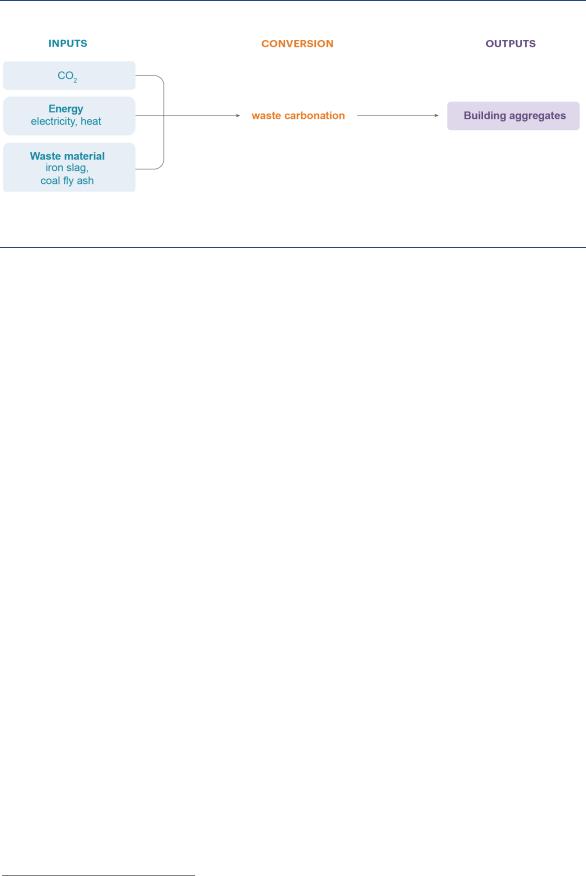
- •Putting CO2 to Use
- •Abstract
- •Highlights
- •Executive summary
- •CO2 is a valuable commodity
- •Early markets are emerging but the future scale of CO2 use is uncertain
- •Using CO2 can support climate goals, but with caveats
- •Cultivating early opportunities while planning for the long term
- •Findings and recommendations
- •Millions of tonnes of CO2 are being used today
- •New pathways for CO2 are generating global interest
- •CO2 use can contribute to climate goals, but with caveats
- •The future scale of CO2 use is highly uncertain
- •Where are the emerging market opportunities?
- •1. CO2-derived fuels
- •2. CO2-derived chemicals
- •3. Building materials from minerals and CO2
- •4. Building materials from waste and CO2
- •5. Crop yield boosting with CO2
- •CO2 use can complement CO2 storage, but is not an alternative
- •References
- •Policy recommendations
- •Technical analysis
- •Introduction
- •Setting the scene
- •What is CO2 use?
- •CO2-derived fuels
- •CO2-derived chemicals
- •CO2-derived building materials
- •Where is CO2 being used today?
- •What has spurred renewed interest in CO2 use?
- •Who is currently investing in CO2 use, and why?
- •How can CO2-derived products and services deliver climate benefits?
- •Understanding the future market for CO2-derived products and services
- •Which factors influence the future market?
- •Scalability
- •Competitiveness
- •The price and availability of hydrogen
- •The price and availability of CO2
- •Climate benefits
- •Origin of the CO2
- •Displaced product or service (reference system)
- •Energy input
- •Retention time of carbon in the product
- •Is it possible to assess the future market size?
- •Scaling up the market
- •CO2-derived fuels
- •What are CO2-derived fuels?
- •Are CO2-derived fuels scalable?
- •Under what conditions would CO2-derived fuels be competitive?
- •Can CO2-derived fuels deliver climate benefits?
- •What are the regulatory requirements?
- •CO2-derived chemicals
- •What are CO2-derived chemicals?
- •Are CO2-derived chemicals scalable?
- •Under what conditions would CO2-derived chemicals be competitive?
- •Can CO2-derived chemicals deliver climate benefits?
- •What are the regulatory requirements?
- •CO2-derived building materials from natural minerals
- •What are CO2-derived building materials?
- •Are CO2-derived building materials scalable?
- •Under what conditions would CO2-derived building materials be competitive?
- •Can CO2-derived building materials deliver climate benefits?
- •What are the regulatory requirements?
- •CO2-derived building materials from waste
- •What are building materials made from waste?
- •Are building materials from waste scalable?
- •Under what conditions are building materials from waste competitive?
- •Can building materials from waste deliver climate benefits?
- •What are the regulatory requirements?
- •CO2 use to enhance the yield of biological processes
- •What is yield boosting?
- •Is CO2 yield boosting scalable?
- •Under what conditions is CO2 yield boosting competitive?
- •Can CO2 yield boosting deliver climate benefits?
- •What are the regulatory requirements?
- •Where are suitable locations for an early market?
- •Implications for policy
- •Public procurement
- •Mandates
- •Economic incentives
- •Labelling, certification and testing
- •Research development and demonstration
- •Recommendations
- •References
- •General annex
- •Abbreviations and acronyms
- •Acknowledgements
- •Table of contents
- •List of figures
- •List of boxes
- •List of tables
Putting CO2 to Use: Creating Value from Emissions |
Technical analysis |
CO2-derived building materials from waste
What are building materials made from waste?
CO2 can be used to convert metal-containing waste materials into stable and solid carbonates with a market value (Figure 27). In many cases, the reaction products can be re-used in several applications, primarily in the construction industry as aggregates. Meanwhile, carbonation with CO2 presents an opportunity to reduce the probability of the metals leaching and causing environmental harm, which may happen when stored in landfill or stockpiled on industrial sites, and to avoid costs associated with waste disposal. A wide variety of waste streams coming from the power or industrial sector could be technically remediated with CO2, including coal fly ash, steel slag, cement-kiln dust, bauxite residue (red mud) and silicate mine tailings (Sanna et al., 2014). Particularly alkaline wastes, such as fly ash and steel slag, make a good candidate due to their high concentration in reactive metals, such as calcium and magnesium ions (up to 40% by weight). The reactivity and CO2-absorption capacity varies per waste type. As for natural mineral-based building materials, the CO2 use rates are relatively low, but the carbon is permanently stored in the material (Sanna et al., 2014). The CO2 use rates vary per type of waste material, with 0.07-0.25 tCO2 per tonne coal fly ash, 0.08-0.25 tCO2 per tonne cement kiln dust and 0.26-0.38 tCO2 per tonne blast furnace slag (Sanna et al., 2014).
Many alkaline waste streams require pre-treatment or extreme operating conditions (elevated pressure and temperature) to react at industrially acceptable rates (ECRA/CSI, 2017). The objective of the pre-treatment is to accelerate the slow carbonation process by increasing the surface area of the material or extracting the reactive metal ion from the mineral using chemicals. Other waste materials and processes require a separation step after the carbonation process. Both the pre-treatment and separation steps are typically energyintensive and costly, in terms of both capital and operating expenses. Furthermore, large amounts of mineral feedstock are required per tonne of CO2 used, which needs to be transported to the carbonation facility. Technological improvements are needed to enhance the CO2-uptake capacity of waste materials under moderate operational conditions (low temperature and pressure) and industrially acceptable reaction times, for example, by developing new catalysts and exploring new conversion pathways (ICEF, 2017). In addition, further insight is required into the effect of the purity level of the CO2 on the vast majority of mineral carbonation technologies. While waste materials can tolerate CO2 at a wide range of purity levels (e.g. 10% to 90%), reaction rates tend to decline with lower purity levels (Alberici et al., 2017).
The main value proposition for companies to react waste materials with CO2 is to reduce waste disposal costs, while creating a saleable CO2-containing product for the construction sector. Companies in different parts of the world are scaling up businesses based on this value proposition, together using around 75 kt of CO2 annually. The main waste streams used are bauxite residue, steel slag and air pollution control residues.
PAGE | 59
IEA. All rights reserved.

Putting CO2 to Use: Creating Value from Emissions |
Technical analysis |
Figure 27. Mature conversion pathway for building materials from waste and CO2
IEA 2019. All rights reserved.
Waste materials can be reacted with CO2 to manufacture building materials.
Are building materials from waste scalable?
Traditionally, aggregates are made from natural resources, such as gypsum, chalk and limestone. The aggregates market alone would be able to absorb quantities of carbonated waste products that correspond with an amount of CO2 in the order of several billion tonnes per year (ICEF, 2017). Several estimates have been made on the global amount of CO2 that could technically be absorbed by waste streams, mostly in the range of 100 Mt/yr to 1 200 Mt/yr (Gomes et al., 2016; ICEF, 2017; Renforth et al., 2011).
The availability of waste streams may be an important long-term constraint due to reduced coal-fired power generation and primary steel production, although legacy waste from stockpiles may be available. Furthermore, technological improvements may unlock the treatment of waste materials that cannot be converted at industrially acceptable rates today. According to the UK-based company Carbon8, around 15 Mt/yr of CO2 can be realistically used for the carbonation of waste materials with current technology, based on the availability of CO2 and suitable waste materials close to the market for building materials (Alberici et al., 2017). In some locations, there may not be sufficient waste material in the short term (three to ten years) as most of it is under contract with waste disposal companies (Alberici et al., 2017).
Under what conditions are building materials from waste competitive?
The relatively low product value of building materials makes it difficult for building materials from waste to compete in the market. Carbonated waste products are only viable if the combined costs of transport, pre-treatment and carbonation, minus the avoided cost of waste treatment, are lower than the product’s market price. Given the low market value of building aggregates, the willingness to pay for CO2 will likely be lower than in the case of CO2- cured concrete. In addition to aggregates made from natural minerals, carbonated waste products would have to compete with alternative waste treatment processes that can extract valuable metals for sale. Nevertheless, Carbon8 has stated that the cost for their waste-based building material is three times lower than that of other secondary aggregates.21 In terms of
21 “Secondary aggregates” are materials that can be used as aggregate but are the waste product of another process. An example is fly ash.
PAGE | 60
IEA. All rights reserved.

Putting CO2 to Use: Creating Value from Emissions |
Technical analysis |
CO2 avoidance cost, a range of USD 50 to USD 300 per tCO2 sequestered was found in literature (Sanna et al., 2014).
Early opportunities involve materials with low processing costs and locations where low-cost CO2 and suitable waste streams exist in close proximity to potential consumers of building materials. The first markets are likely to emerge in places where these conditions exist as well as where costs of waste disposal are high. Currently, the European Union is attractive from this perspective. Regions producing aluminium are also promising because of their scale and tightening regulations on so-called “red mud” waste. An example of a company exploiting early opportunities is Carbon8 (Box 10).
Box 10. Commercial building materials from waste: The case of Carbon8
Formed in 2006, the British company Carbon8 is among the global leaders making building materials out of industrial waste and CO2. Today, the firm is operating two commercial carbonation plants producing lightweight aggregates from municipal air pollution control (APC) residues in the United Kingdom. Both plants are located next to a concrete manufacturer that uses the Carbon8 product in dense and medium-dense aggregate blocks. The company’s business model is based on two streams of revenue: a fee for waste treatment and the sale of its product. Carbon8’s material is reportedly three times less expensive than most other recycled aggregates (Alberici et al., 2017).
On an annual basis, the plants collectively use around 5 kt of high purity CO2 to convert 60 kt of APC residues, which would otherwise be treated and disposed to landfill or stored in salt caverns. If cheaper CO2 (with lower purity levels) was available, even more wastes could be processed economically with the company’s technology, such as cement dust and steel slag. The energy consumed across the value chain is relatively small, due to the short transport distances and little need for pre-treatment. According to Carbon8, the process fixes more CO2 in the aggregate than it emits over its life cycle, resulting in the first carbon-negative aggregate on the market (Carbon8, 2019).
The company aims to have five to six plants in operation by 2021, using around 19 kt/yr of CO2. It may be challenging to find sufficient material to process in the near future as most companies producing these materials are under contract with waste companies. In addition, local policies restrict plant output capacity to 30 kt/yr, while EU waste regulations forbid the use of certain waste streams in commercial products (Alberici et al., 2017). These barriers could seriously delay the company’s growth plan.
Can building materials from waste deliver climate benefits?
The permanent storage of the carbon in the building material is a major contributor to the low life-cycle emissions in comparison to those of conventionally produced aggregates. While not all CO2 used is locked up in the carbonate product, the cost of the CO2 input encourages recycling of unreacted CO2. This means that the vast majority of the CO2 input is sequestered. The overall CO2 emission reductions depend particularly on the energy consumption for the
PAGE | 61
IEA. All rights reserved.

Putting CO2 to Use: Creating Value from Emissions |
Technical analysis |
pre-treatment and reaction of the waste materials and the transport of both the inputs and carbonate products. Industrial areas where suitable waste materials, CO2 and potential product off-takers coexist are good locations to manufacture carbonate materials with maximum overall emissions reductions.
The availability of robust and transparent life-cycle assessment studies on carbonated waste products is very limited. Carbon8 reports an absorption rate of 40 kgCO2 per tonne of aggregate, although this depends on the type of waste material (Carbon8, 2019). In addition, the firm claims that more carbon is permanently stored during the process than emitted as CO2 in its manufacture, resulting in a carbon-negative aggregate. However, this cannot be verified because the underlying assumptions are not reported.
What are the regulatory requirements?
Existing regulations, such as the EU End of Waste Regulations, may prohibit the integration of waste in commercial products. A revision of such regulations is needed to allow the use of certain waste materials, provided the environmental integrity of the end product can be guaranteed. Meanwhile, imposing stricter waste disposal regulations may improve the business case for the carbonation of waste materials using CO2. The UK Landfill Tax and Australian bauxite residue disposal rules are currently the main existing enablers for commercial activities in this area. Lastly, the conservative building sector may not readily accept novel building materials. Multi-year trials demonstrating the safe and environment-friendly performance of these products would facilitate this process. In the meantime, targeting market segments that are more receptive towards novel building materials could be an effective strategy.
Table 6. Scaling up to a 10 MtCO2 market for building materials from waste and CO2
|
Technology |
|
No major breakthroughs are needed for regular steel, bauxite and air pollution |
||
|
|
control waste. |
|||
|
|
|
|
||
|
|
|
|
|
|
|
|
|
|
The aggregates market is large enough for the use of 10 MtCO2/yr, which |
|
|
Scalability |
|
|
equates to around 120 Mt of aggregates. |
|
|
|
|
In some locations, there may not be sufficient waste material in the short term as |
|
|
|
|
|
|
|
|
|
|
|
|
it is under contract with waste disposal companies. |
|
|
|
|
|
Building materials from waste and CO2 may already be competitive with other |
|
|
Competitiveness |
|
secondary aggregates. |
||
|
|
Early markets may be found in locations with high waste disposal costs and |
|||
|
|
|
|
||
|
|
|
|
coexistence of suitable waste materials, CO2 and product off-takers. |
|
|
|
|
|
|
|
|
Climate benefits |
|
|
As transport distances, pre-treatment of waste materials and carbon uptake in |
|
|
|
|
the product have a strong impact on climate benefits, they should be optimised. |
|
|
|
|
|
|
|
|
|
Regulation and other |
|
Existing regulations may prohibit integration of waste in products. |
||
|
|
Multi-year trials are required to demonstrate safe and environment-friendly |
|||
|
issues |
|
|||
|
|
performance. |
|||
|
|
|
|
||
|
|
|
|
|
|
PAGE | 62
IEA. All rights reserved.
